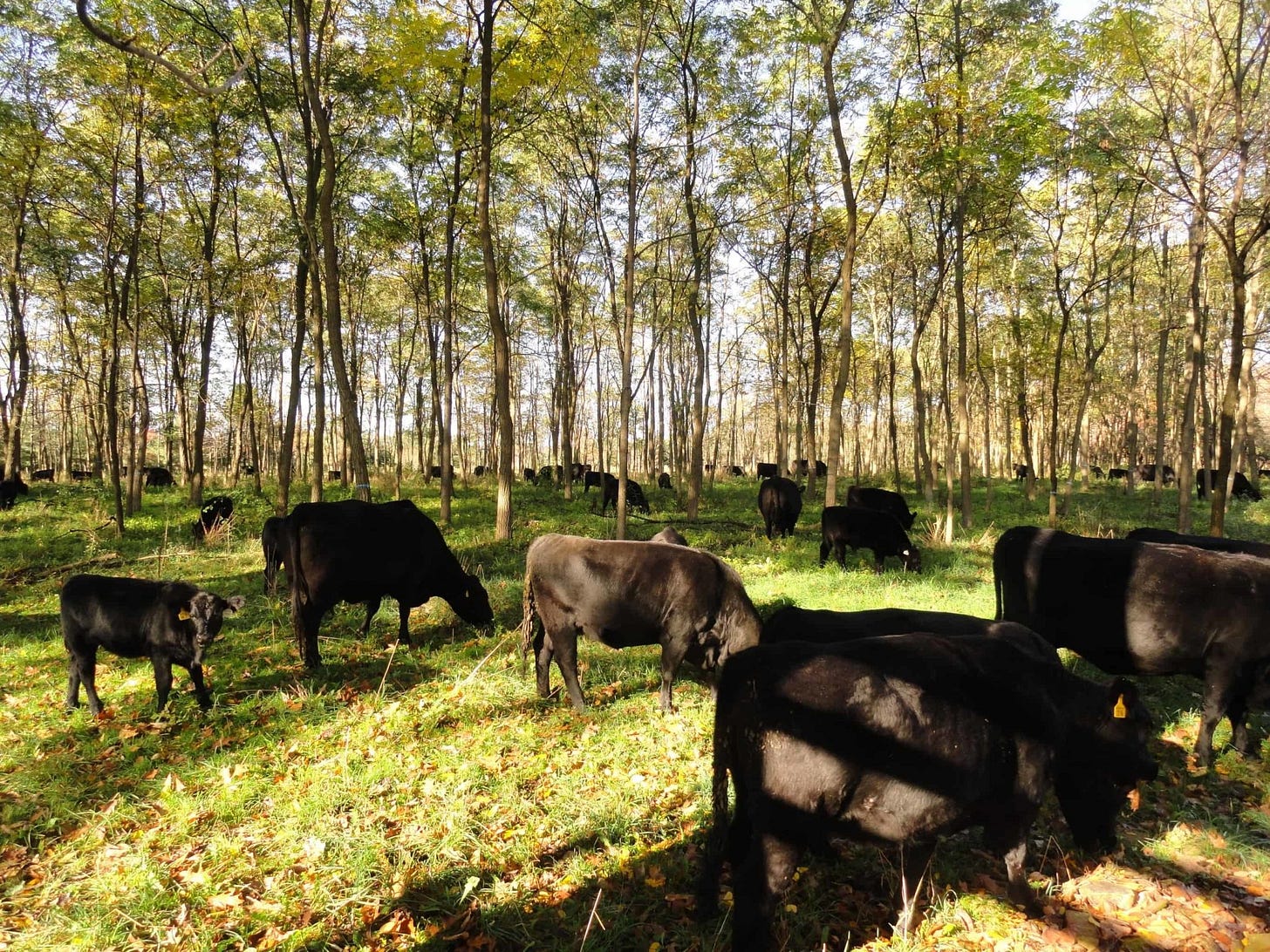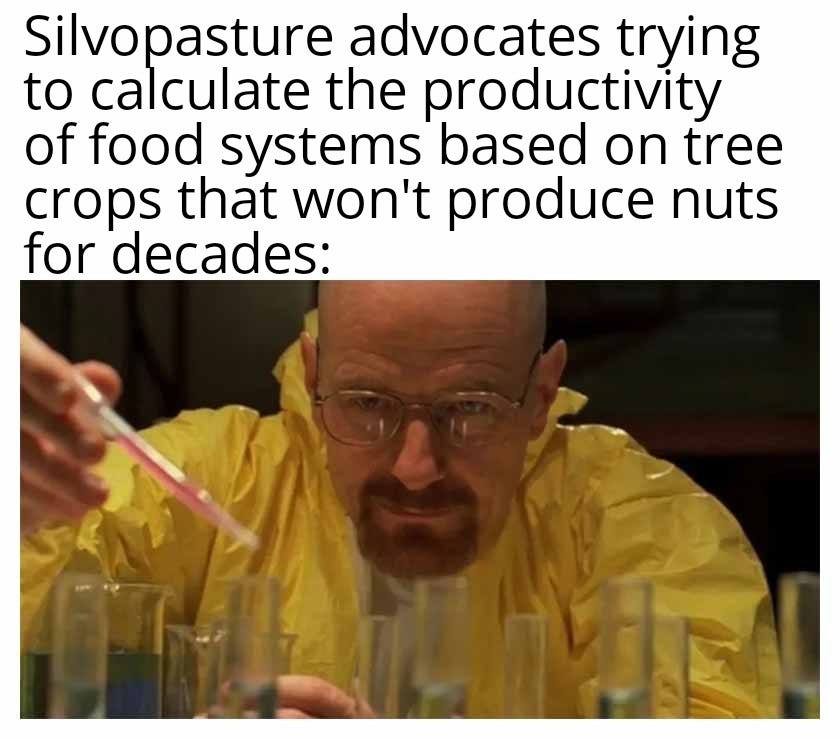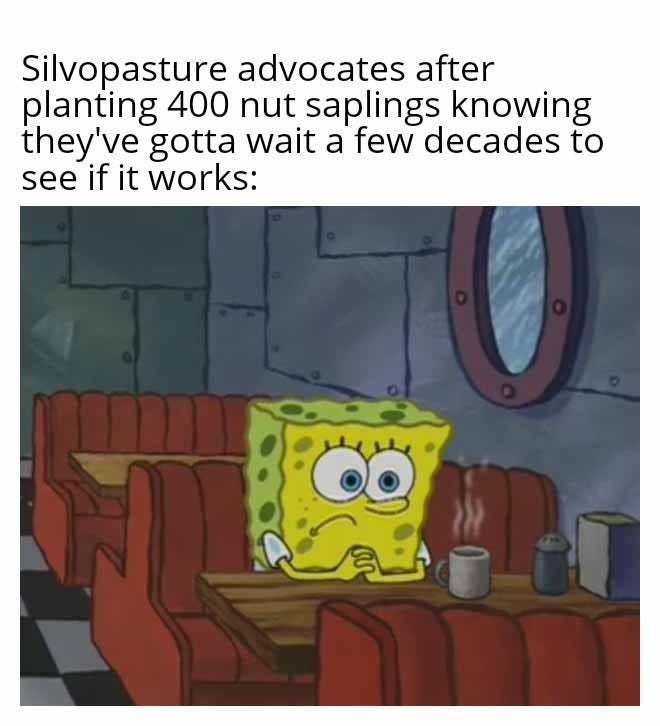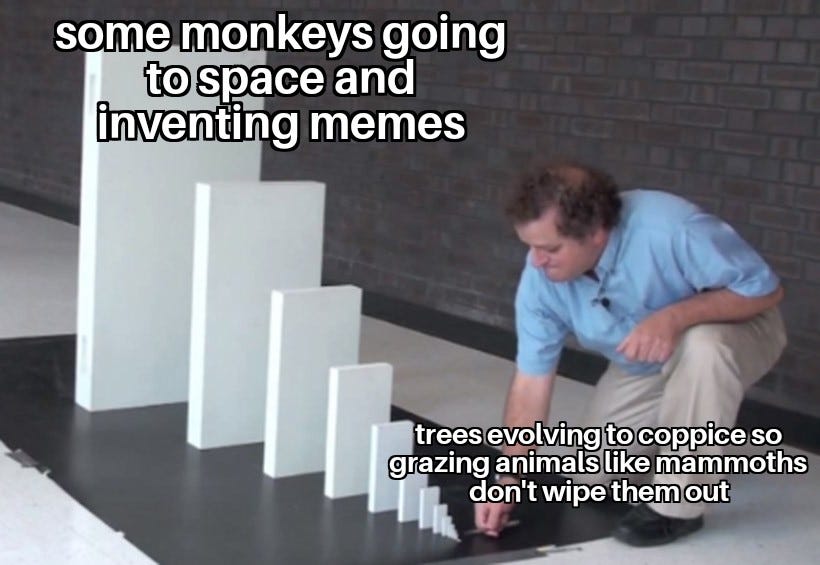Layering Complexity: Exploring Silvopasture
An integrative approach to historical management and modern agriculture

The concept of grazing livestock in multilayered ecosystems (trees & grasslands or brush) has a long and diverse history, and is exceptionally common in more arid parts of the world, such as India.1 Functionally, what we’re discussing when we talk about silvopasture is bringing the things we have explored so far together— ecosystem management, orchard management, fruit trees, orchard understory, and the historical context of ecosystems. We have constantly talked about mimicking natural systems, and it only makes sense that, since animals don’t only live in grass fields, and that we know perennials have stronger root structures & can also produce more green fodder because of those larger root structures, wouldn’t it make sense and create a more resilient food system by restructuring our idea of food systems to be like that?
A lot of what we’re talking about had thousands of years of applications in direct alignment with local ecosystem needs, yet despite this, little of it was written down. Today, we’re relearning how to produce food in this way. The definition of silvopasture is a good place to start this conversation; which is an intentional combination of trees, forage plants, and livestock together as an integrated, intensively-managed system. What we are talking about really, is a stacked system of outputs that reinforces food resiliency.
There’s two general areas of silvopasture that I want to focus on primarily, that aren’t well covered in previous sections of this podcast— using fruit and nut trees to feed your animals, and maybe even yourself, and the use of leaves as a replacement or supplement for grass feed, or even salad greens.
The first part is becoming fairly popular, thanks to the foodie movement. Chestnut finished pigs, apple-finished pigs, and, well a lot of folks finishing pigs on specific fruits and nuts. These aren’t by any means new products, but rather ones that have been reinvigorated over the past few decades in response to the homogenization of our global food system due to the Green Revolutions and the rise of petrochemical fertilizers. I’m a firm believer that we cannot fix our food system without understanding why it is the way it is today, and we have an extensive (and growing) catalogue of content exploring these narratives which have led to our industrialized food system.
But back to silvopasture; the focus of these systems isn’t just to clean up the mess of rotten apples and bring them over to your pigs, or bring the pigs in one time a year, but to have your rotational grazing system designed around the fruit drop in order increase forage and to reduce labor hours on you. This can also be exploited by having fruits with longer fruiting seasons, like mulberries, which can drop fruit for a number of months, meaning grazing those sites will have far more calories available to your animals than simply letting them graze the grasses, all while still keeping fruit available for your own enjoyment.2
For example, a full size apple tree can drop up to 400 pounds of fruit, and you can usually get more than one or two trees on one paddock, meaning that, even if you harvest half of the fruit from, say, 5 trees, you’d still be looking at an additional 1000 pounds of forage for your livestock. Obviously, there will be fruit losses and additional maintenance, but losses shrink significantly when animals don’t care about wormy apples. Now, one thing to keep in mind is that this is still a bit of a messy area from a legal/safety perspective right now, and I’m in no place to make a scientific argument about the safety of silvopasture for food systems in terms of viruses, although folks like the Savannah Institute are ardent advocates for reconsidering how tree crops are treated around livestock.
In terms of production, while sunlight is the most important thing for us to capture, we have to remember some of the general rules of photosynthesis. C3 and C4 grasses are more efficient at certain temperatures, and in fact, stop being able to photosynthesize in hot temperatures. Fortunately, in a savanna, where dappled light gets through a top canopy, the 100 degree day may only feel 80 degrees, and while the trees may struggle to photosynthesize, now there’s a different layer that IS capable of photosynthesis. This is a net positive while also reducing heat stress on livestock, reducing water needs, and so on.
Now tree hay, or leaf litter, or tree fodder, whatever term you choose to use is the use of young branches with leaves to supplement your grazing system, and is an easy way to store food for the winter. Unfortunately, this ancient practice has been largely forgotten, and only recently has a book been written with any depth to the subject in English and it was from one of our guests on the show, Mark Krawczyk.3 The process of harvesting leaves for feeding animals can be done with trees around pasture, trees interspersed within a pasture system, or a forest-type system. The last one is where we’re going to focus for now, and generally speaking this falls under the term agroforestry. Agroforestry can mean a bunch of different things, but it’s important to keep in mind our episode on forest ecology and succession as we try to envision the agroforestry system that best fits our needs and our site’s needs.
Anyone who has seen an abandoned lot or pasture has seen when woodier plants, things like briars to small brush that have come in and taken over. Behind the thistles and milkweed and blackberries come the fast growing trees and larger bushes. The mix of plants is usually vines that had existed right outside the lot, taking advantage of the unprotected soils, or plants with light seeds, especially stuff like dandelion which has its own parachute for traveling. The old field will becomes covered with brush as these plants dominate the site. Animals like deer and rabbits will keep some woody plants in check by nibbling branches. It’s in this successional “brushland” that is the birthplace of humankind’s domesticated animals, and in fact is either the original homeland of Homo sapiens itself or a key component of the diverse landscapes necessary to support our origins.4 This brushland is a savanna, a rich, diverse grassland with scattered brush, fruits, nuts and berries. The savanna biome, as this successional stage is called, is arguably the most productive land ecosystem on earth. The savanna is the second richest biome on earth (behind tropical and sub-tropical moist broadleaf forests), but on a pound-for-pound basis more mammals can live in a savanna than anywhere else on land, on earth.5
Cows, goats, sheep, and pigs are all domesticated savanna species. The savannas are such richly abundant systems that they even supported the largest land mammals ever to live on planet Earth, the mammoths. In terms of ability to manipulate the landscape, elephants were kings; they were the land managers that maintained the savannas of the world as an open woodland, or a brushy prairie. There’s researching going on today actually which focuses on imagining what forests looked like before human intervention, and because of the massive megafauna like elephants, it’s thought that most of the forests looked pollarded and coppiced from the incredibly large plant-eaters.6 Like, the trees were trimmed down the way we trimmed down grasses. It was these elephants that helped to create that savanna where we as a species learned to hunt and thrive. It shouldn’t be surprising, with this in mind, when we think back to the episodes we did on indigenous agricultural systems, that practices of coppicing and pollarding were utilized to create similar landscapes, especially paired with prescribed burns in specific parts of the world.
So it was the end of the last ice age was when humans first began to arrive in North America. When humans arrived in the Americas, a continent-wide, mass extinction began that included a majority of the megafauna. There’s generally two trains of thought around what exactly happened; the most common one is that those animals had never experienced humans before and were unable to adapt to the hunting pressure that they experienced. I’m personally not really sold on that, and I tend to believe that as plant species evolved with the climactic changes and as their seed dispersals systems were changing, the food chain was simplified as selection pressure tightened, which further stressed the systems to support these massive animals, which required incredibly complex systems to sustain them. Add in humans as what would be treated at the time as a non-native species, and we were likely the final straw, but not the main piece responsible. Some recent research came out this past spring from Natalie Mueller suggesting that sweeter fruits become more common during this time and this was part of why agriculture began to develop, but that’s a conversation for another day. 7
As these megafauna began to go extinct, so did a whole chain of organisms including the dependent parasite, birds, and a whole host of other animals. Birds like the Oxpecker and the North American aquatic rhinoceros lived in symbiosis as well as things like the mastodon, for example, feeding one another and providing one another with shelter and safety. This deep, interconnected diversity is what created the deepest, most fertile soils on the entire planet — those deep, fertile soils of the midwestern United States — it was the temperate, humid elephant savannas of North America. That same diversity is what also provided resilience and stability to the system. If one pest or disease became a limiting factor on part of the system, other parts of the system were still healthy and whole.
In order to successfully create these types of systems, meaning a diverse, resilient ecosystem, you must first have a basic understanding of what the biome is where your site is being established. In addition to the particular species of a place, biomes are also defined by the particular successional pathway that occurs in that region (we chat about biomes in detail here). For example, where I’m located in coastal New England, oak-hickory forests are the last succession for our pine-oak forests, and they produce significantly more food for both humans and other animals. These systems aren’t plug and play; different species play out the dance of succession differently in each region. Just because you want specific species, doesn’t mean that those species, even if they can handle the soil type and climate, are the best fit because of the biological relationships they have with the wildlife. Sure, most wild animals, bacteria, and fungi can likely utilize the crops you grow, but that doesn’t mean you’re going to have the benefits of thousands of years of co-evolution that you would with native species.
To be clear, this doesn’t mean you can’t grow non-native species, but rather that you should consider those to be supplemental species for your site, not necessarily the primary species. Thinking about substituting species, say, edible cherries or other similar rosaceae species for, say, black cherry, which is native here but the cherries are, with the exception of the juice— inedible, helps (but isn’t a complete substitute) to bridge those biological gaps. Knowing your biome and knowing the individual species that take part in the successional progression of your place will give you the highest likelihood of success. Think about it. If you plant trees, shrubs, canes, vines and forage that would naturally occur in your region anyways, don’t you think that they would have a greater chance of success than if you grew other plants that are not adapted to the region?
In most biomes, the entire character of that biome is most influenced by its trees. Trees, being the largest and longest lived members of that particular plant community, have the longest time to affect an area. Annually they pull mineral nutrients up from deep layers in the earth and combine those mineral nutrients with carbon dioxide that they inhale from the atmosphere. Over time certain tree species come to chemically dominate a site. If you think about it, it makes sense; the surface soil is created by their leaf drop and then increasingly deeper soil layers become “flavored” to that particular tree species (and any associates who can tolerate or thrive in this new condition). Some trees, like the Juglandaceae family (walnuts, hickories, pecans, etc.) release juglones that are actual herbicides that kill or stop the growth of many other plants (the science on this is debated as to the extent juglone actually impacts other species). They don’t kill all the plants around them, however, they just exclude the plants that aren’t in their family or haven’t co-evolved with them. This change in the soil chemistry and soil life is one of the reasons why we are able to distinguish changes between biomes. This is also why practices like Korean Natural Farming can help accelerate these successive processes, as you’re essentially inoculating your site with the biology needed for those species to effectively provide sustenance for your site. The largest and most dominant tree species are what set the rules for the site. Learn your biome. Get to know the soil types, the rainfall patterns and what kinds of trees live (or have lived pre-European settlement) in your location so that you can learn how to fit into the site in the most effective way possible. Wherever you live, and whatever biome it is, you will have greater success if you imitate what was there.
As mentioned before, the biome that has the widest distribution across North America, is the savanna. The particular form of savanna that is most widespread in North America is the oak savanna. In oak savannas, there are a handful of plants that you’re likely to see— generally you’ll see (for food-producing species) oaks, chestnuts, walnuts, hickories, and beeches and below the canopy you’ll see apples, hazelnuts, cherries, and plums, and beneath the tree layer you’re likely to see raspberries, blackberries, and grapes (and many more). Of course, there are other common plants— pines, cedars, and so on— but I want to focus on edible varieties, and ones that are more or less fairly standard across most of the country.
What we are doing is designing an agricultural system that closely mimics the savanna in its structure (vertical structure as well as spatial distribution), the species mix (with some cultivated substitutions), and ecological function. While we want to use native species as the predominant larger species, we can use select cultivars for our oaks, hickories, and so on, and beneath the main canopy we can use more domesticated plants, plants that have been bred through the years to produce high crop yields every single year.
So let’s start talking about large trees that drop nuts. While acorns are not attractive as a consumable food for many, they can be. Selective cultivars exist, and folks around the country are working to take advantage of the vast pool of genetics that exists for one of the most diverse tree species in North America. Plus, animals like pigs are great at converting what’s inedible to us into more pig, which is edible to us. Beech nuts also have a similar reputation, and pigs are also big fans.
The Prunus group is a broadly diverse genus of woody plants that includes cherries, plums and peaches. If your property or biome is home to native North American black cherries, there is a high likelihood that other cherries, plums, and peaches will do well on this site, given the right amount of light access.
While some variety of oak biome is the largest across the united states, the second largest naturally forming functional biome is structured around riparian zones— those regions where occasional flooding takes place and the ground can become saturated with water. We had said before that savannahs are the highest producing sites for energy absorption on land, but under water is even more incredibly productive, and these cycling processes has allowed the landscapes to get the benefits of both.
These regions, unlike water-saturated floodplains, the riparian zones referred to here have moist and fairly well-drained soil. The species adapted to this can tolerate being submerged for short lengths of time, but they don’t really appreciate waterlogged soil that becomes anaerobic. Sites like these are perfect locations for the plant family associated with trees in the Juglandaceae family.
The native species we see in this biome include primarily pecan & black walnut as the primary species, with an understory of prunus again: cherries, plums, peaches. We also see a lot more shorter, bushier understory trees like pawpaw, nannyberry, and mayhaw, followed by shade-tolerant, fruit-bearing shrubs like Raspberry & blackberry, and even vines such as Grape & passion fruit.. Pecans are not as cold-hardy as black walnuts and black walnuts are not as cold-hardy as the butternuts which also can be used in this system. Many of the most common varieties of almond and Persian/ English walnuts (Juglans regia) are susceptible to various fungal diseases in humid eastern North America. Most of these species, even if folks don’t have personal experience eating, they are mostly familiar with them as a food, unlike acorns and beechnuts. In Mark Shepard’s book, “Restoration Agriculture”, he highlights this conundrum of modern man, in that while we often know of foods that are edible, we have no practical experience, and when we do eat them, they are simply a novelty and don’t help us wean ourselves off of, what he calls the needs of annual agriculture, which is the primary driver in soil degradation.8
Ultimately, what we’re essentially trying to do is look at how we can plug in species into a system where they can feed the landscape, ourselves, while not demanding the ecology do anything but what it’s trying to do; go through its natural progressions and maintain those already-existing, local biological. While we are looking to nature for guidance, we are also using some of the tools at our disposal, plants we have selectively bred over thousands of years, in some cases, that will not only thrive in the right conditions because of a biome, but also provide more edible crops for us. Most research today suggests this is what indigenous folks had done for thousands of years on the north american continent, and explains why the most edible crop on the continent, the American chestnut, had been so widely dispersed— in fact, 1 in 4 trees at the time it was wiped out was an American Chestnut.9 I have no doubts that wasn’t an accident, and I have no doubts that had colonists not shown up, today acorns would be considered as edible and enjoyable as any other nut crop due to continued selective breeding I’m sure they had been working on.
So, what we are trying to do is target specific plants that can both fill an ecological niche within its ecological community and provide edible crops for both ourselves and our sheep, goats, chickens, cows, or whatever you’ve got or are thinking about getting. What we don’t or can’t eat because of quality issues or simply volume can be utilized by our grazers.
While these examples of filling ecological niches within the layers of a forest are pretty easy to see, what becomes less easy to see are the seasonal ecological niches— the plants that spring up first in the year and dissipate as the leaves of the trees fill in and block the sun, the fall goldenrod that provides the last bit of pollen for the bees and takes advantage of the last bits of sunlight for the year, and so on. These take time, and these are a part of why I felt it was necessary to start with talking about the big picture— the efficiency of complex systems, and the need to listen to the ecology first and to not start just digging up your site and cutting down what’s there, even if you know you don’t want it. This stuff is complex, and we’ve only been scratching the surface of these various subject areas in the context of ecology and agriculture. This is why my advice to first time gardeners, to folks that are very excited to start applying principles from ideas like permaculture, is to wait and watch the property they are working on.
The third piece of this ecological niche, which I’ve covered very briefly at this point, is the role of animals within the ecology. One reason why fewer people have experiences with animal polycultures is that they almost constantly change in both place and in time based on a number of factors. Even in the most inner-city location in the world, there is a polyculture of animals living there. Most of the time, however, we don’t get to see them all at once in the same place at the same time. That is because animals, left to themselves, will move to the place where they find the most or highest quality of whatever it is that they eat at the time. If their food is not where they are, they’ll move. Much like the systems we have talked about, especially in the first chapter of complex systems theory, efficient systems create layers where there isn’t much in terms of competition, but niches filled and efficiencies gained by specializing species. But, I think it’s right about here that we’re going to wrap up the first chapter on silvopasture. We’ve covered the basics of the forestry component of it and dipped our toes into the seasonality of the floor of the forest, but shortly we’re going to start talking about the animals that inhabit these sites, and how that plays into the forest floor, particularly around site brittleness and how that is a key factor in guiding what we can and cannot do.
If you’ve enjoyed this piece, which is equal to a 16 page chapter, of (so far) a 578 page book with 252 sources, you can support our work a number of ways. The first is by sharing this article with folks you think would find it interesting. The second is by listening and sharing the audio version of this content (Episode 56, listen here), the Poor Proles Almanac podcast, available wherever you get your podcasts. If you’d like to financially support the project, and get exclusive access to our limited paywalled content, you can become a paid subscriber on Substack or Patreon, which will both give you access to the paywalled content, and in the case of Patreon, early access to the audio episodes as well.
Köhler-Rollefson, Ilse. Hoofprints on the Land: How Traditional Herding and Grazing Can Restore the Soil and Bring Animal Agriculture Back in Balance with the Earth. Chelsea Green Publishing, 2023.
Eliza Greenman has a trove of information of pig farming around tree crops here: https://elizapples.com/
Mark’s book “Coppice Agroforestry: Tending Trees for Product, Profit, and Woodland Ecology” is as of 2023 available now just about anywhere for purchase and is a worthwhile addition to any collection.
Vignaud, P. et al. (2002): 'Geology and palaeontology of the Upper Miocene Toros-Menalla hominid locality, Chad' in Nature, Volume 418, p. 152-155
Anderson, T. Michael, et al. “The Spatial Distribution of African Savannah Herbivores: Species Associations and Habitat Occupancy in a Landscape Context.” Philosophical Transactions of the Royal Society B: Biological Sciences, vol. 371, no. 1703, 2016, p. 20150314, https://doi.org/10.1098/rstb.2015.0314.
https://www.americanforests.org/article/the-trees-that-miss-the-mammoths/
I can’t seem to find where I read this, but I believe it was a proposition made in her blog where she’s a bit more exploratory instead of analytic— check it out here: https://ngmueller.net/
Shepard, Mark. Restoration Agriculture. Acres U.S.A., 2013.
https://timeline.com/american-chestnut-trees-disappeared-39217da38c59









This is great, so glad you explain the importance of natives. I didn’t know any of this when I started. I had all these native ficus (figs and berries) that were in my way and I’d try and remove them in my stupidity, while putting in my fruit trees. Now that I know better. These ficus trees attract so many birds into our property and the birds do a lot of the native tree planting for me now. It’s fantastic. I scythe, so very easy to see new tree seedlings and careful now around them.
I’ve done an agroforestry system, originally I started with a poor understanding of syntropic agriculture but the management was a bit too much, I’m a slacker. We rotate chickens through the system and also have a cow and she’s the fattest cow in the neighborhood. The shade from the agroforestry system is becoming absolutely critical here in the tropics, temperatures in the summer are getting ridiculous and the shade is a lifesaver
Thanks Andy, good stuff.
Is there a podcast about this article somewhere?